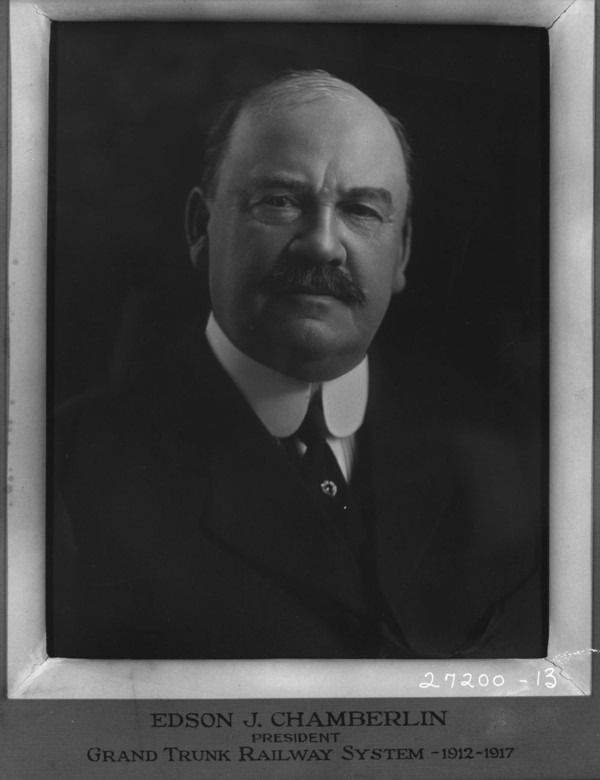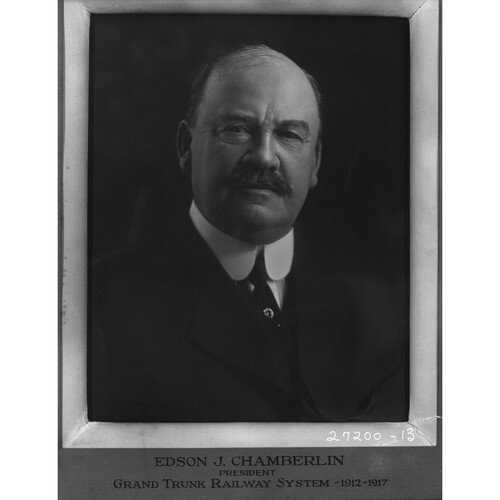CHAMBERLIN, EDSON JOSEPH, railway official; b. 25 Aug. 1852 in Lancaster, N.H., son of Joseph Mark Chamberlin and Rae Ann ---; m. 1876 Sara Griffin Place in St Albans, Vt.; they had no children; d. 27 Aug. 1924 in Pasadena, Calif.
Edson J. Chamberlin was educated at local elementary schools and at the Montpelier Methodist Seminary in Montpelier, Vt. He entered the service of the Central Vermont Railroad in 1871, and worked in several junior positions before being appointed secretary to the president and the general manager. In 1884 he became superintendent of the Ogdensburg and Lake Champlain Railroad, which provided the Central Vermont with connections to the St Lawrence and the Great Lakes. He was also responsible for the ships of the Central Vermont that plied between Chicago and Ogdensburg, N.Y.
After two years with the Ogdensburg and Lake Champlain system – he would return to the Central Vermont as president in January 1913 – Chamberlin moved to Ottawa to become general manager on 1 Sept. 1886 of the much larger Canada Atlantic Railway, controlled by timber magnate John Rudolphus Booth. This railway, which enjoyed traffic exchanges with the Grand Trunk, the Northern, and the Central Vermont systems, served as a vital transportation link between the upper lakes and Lake Champlain. As general manager, Chamberlin also took an interest in timber operations in the Ottawa valley, which provided most of the railway’s local freight; for 17 years he was president of the Colonial Lumber Company Limited, based in Pembroke, Ont.
Chamberlin developed a modest presence in Ottawa society. By the late 1890s he and his wife, an American, were living at 333 Metcalfe Street, and in 1897 Mrs Chamberlin was president of the Ottawa Decorative Art Society. A clubman and golfer, Edson was still mostly interested in railways; he was a director of the Montreal, Portland and Boston, but his primary focus was the CAR.
The strategic location of the CAR would make it a takeover target for all three of Canada’s transcontinental systems: the long-established Canadian Pacific, the Canadian Northern, and the Grand Trunk Pacific/National Transcontinental. In mid 1904 negotiations were sufficiently advanced that an announcement of purchase by the Canadian Northern was widely anticipated. At the last minute, however, the federal government intervened and the CAR was acquired by the Grand Trunk Railway, effective 1 Jan. 1905. The sale was disappointing to many of those involved in the earlier negotiations, and resulted in Chamberlin’s immediate resignation, though he would retain his position with Colonial Lumber and continue to maintain a residence in Ottawa. Following his abrupt departure from the CAR, he engaged in railway contracting in Canada, South America, and Mexico. He formed, for instance, the Standard Construction Company, which obtained contracts for sections of the Morelia and Tacambaro Railway through the state of Michoacán in Mexico. He was also the railway’s president.
In 1909 the elevation of Charles Melville Hays* to the presidency of the Grand Trunk resulted in Chamberlin’s appointment that year as vice-president and general manager of the Grand Trunk Pacific, an affiliated company whose main line was to extend from Winnipeg to Prince Rupert, B.C. The government-built National Transcontinental Railway, which the GTP in 1904 had agreed to lease once construction was completed, was to link the GTP and the Grand Trunk’s eastern system. In 1909 both the GTP and the NTR were still being built, but the former had already become embroiled in several local disputes that tarnished its image in western Canada. Construction of its main line was being financially assisted by the federal and provincial governments. GTR officials, however, were disappointed when, mainly because of western demands, Ottawa also granted assistance to the rival Canadian Northern. There was insufficient western traffic to justify two new transcontinental systems. The GTP was particularly vulnerable: it was being squeezed in the south by the CPR and in the north by Canadian Northern branch lines. As a result, it never developed an adequate traffic base; its prospects were further undermined when construction costs on its lines and on the NTR significantly exceeded original estimates. The GTP could become profitable only if there were many years of sustained immigration and settlement.
A month after the unexpected death of C. M. Hays, when the Titanic sank in April 1912, the GTR’s directors chose Chamberlin as his successor. (By this time he was evidently living in Winnipeg.) It was his misfortune to take over the presidency just when the affairs of the GTP and the NTR threatened to draw them, and the affiliated GTR, into a financial morass. Fear of a possible European war made it difficult and much more expensive to borrow money at a time when the GTP and the NTR were facing heavy construction costs. Restrictions on emigration by various European governments were reducing the flow of settlers to the west, and with the outbreak of war in 1914 the cost and availability of labour, rolling stock, and supplies would become extremely problematic. Chamberlin’s skills fell short of the leadership needed to contend with these difficulties, which may well have been insurmountable. Cast by railway historian G. R. Stevens as a muddler of “mediocre” ability, in August 1913 Chamberlin unwisely, and publicly, confirmed the GTP’s obligation to take over the NTR at its completion. (The last spike would be driven on 17 Nov. 1913.) He had a knack, moreover, for irritating key members of the federal cabinet, including finance minister William Thomas White*.
Chamberlin and other Grand Trunk officials responded to the crisis facing them in several ways. They attempted to reduce costs but felt they had to complete the main line and open it to traffic as quickly as possible. More troublesome were the terms under which the GTP was to lease the NTR, from Winnipeg to Moncton. In light of its huge cost overruns, this line could not be operated profitably, and Chamberlin tried hard to alter or escape the terms of the lease, or at least delay the takeover by finding fault with work the government believed was satisfactory. The government did not back off. In January 1915 the minister of railways and canals, Francis Cochrane*, called on the GTP to assume responsibility for the eastern division without delay. Again Chamberlin prevaricated, and owing in part to his efforts the GTP never would take over the NTR.
Grand Trunk officials hoped the government would either take control of the western lines or allow the GTP to go into receivership without dragging the parent company into bankruptcy. Instead, in June 1916 the government appointed a royal commission to recommend solutions to the problems of the GTR/GTP/NTR and the Canadian Northern, which too had become heavily obligated to the government [see Sir William Mackenzie]. That fall the commission gave Chamberlin a golden opportunity to state how his company “might have suffered hindrance in carrying out its programme.” His written report, in G. R. Stevens’s estimate, constituted an “appalling gaffe.” Chamberlin’s harsh criticism of the assistance given the Canadian Northern, his inflammatory rhetoric, and his vehement defence of GTR policies based on excessively optimistic projections of western development antagonized the commissioners, and key politicians and government officials as well. When Chamberlin later testified in person, he only managed to confirm the GTR’s dire situation.
The commission reported in April 1917 but was divided over what course to take. The government decided in June to nationalize the Canadian Northern and to give $7.5 million to the GTP, a move that was tantamount to taking over the Grand Trunk system. Complicated and messy, this transfer would take another two years to accomplish, but it was clear that the GTR and its president had lost the battle. Elderly, angry, and in poor health, Chamberlin resigned on 29 Aug. 1917. It was left to his successor, Howard George Kelley, to obtain what shareholders thought was fair compensation.
Chamberlin spent the last years of his life in declining health in Pasadena, where he died in 1924. A Canadian Press dispatch announcing his death described him as “one of the most competent and successful railwaymen in the Dominion.” Historians have rendered a much harsher judgement on his career.
LAC, RG 31, C1, 1901, Ottawa, Central Ward, div.8: 25. Globe, 28 Aug. 1924. New York Times, 28 Aug. 1924. Canadian men and women of the time (Morgan; 1898 and 1912). A. W. Currie, The Grand Trunk Railway of Canada (Toronto, 1957). Frank Leonard, A thousand blunders: the Grand Trunk Pacific Railway and northern British Columbia (Vancouver, 1996). H. A. Lovett, Canada and the Grand Trunk, 1829-1924 . . . ([Toronto, 1924]; repr. New York, 1981). J. N. Lowe, “Canada’s third transcontinental railway: the Grand Trunk Pacific/National Transcontinental railways,” Journal of the West (Los Angeles), 17 (1978), no.4: 52-61. Poor’s manual of railroads (New York), 1909. G. R. Stevens, Canadian National Railways (2v., Toronto and Vancouver, 1960-62), 2. F. A. [A.] Talbot, The making of a great Canadian railway . . . the construction of the nearly completed Grand Trunk Pacific Railway from the Atlantic to the Pacific . . . (London, 1912). Who’s who and why, 1919/20.
Cite This Article
Theodore D. Regehr, “CHAMBERLIN, EDSON JOSEPH,” in Dictionary of Canadian Biography, vol. 15, University of Toronto/Université Laval, 2003–, accessed December 31, 2025, https://www.biographi.ca/en/bio/chamberlin_edson_joseph_15E.html.
The citation above shows the format for footnotes and endnotes according to the Chicago manual of style (16th edition). Information to be used in other citation formats:
| Permalink: | https://www.biographi.ca/en/bio/chamberlin_edson_joseph_15E.html |
| Author of Article: | Theodore D. Regehr |
| Title of Article: | CHAMBERLIN, EDSON JOSEPH |
| Publication Name: | Dictionary of Canadian Biography, vol. 15 |
| Publisher: | University of Toronto/Université Laval |
| Year of publication: | 2005 |
| Year of revision: | 2005 |
| Access Date: | December 31, 2025 |




